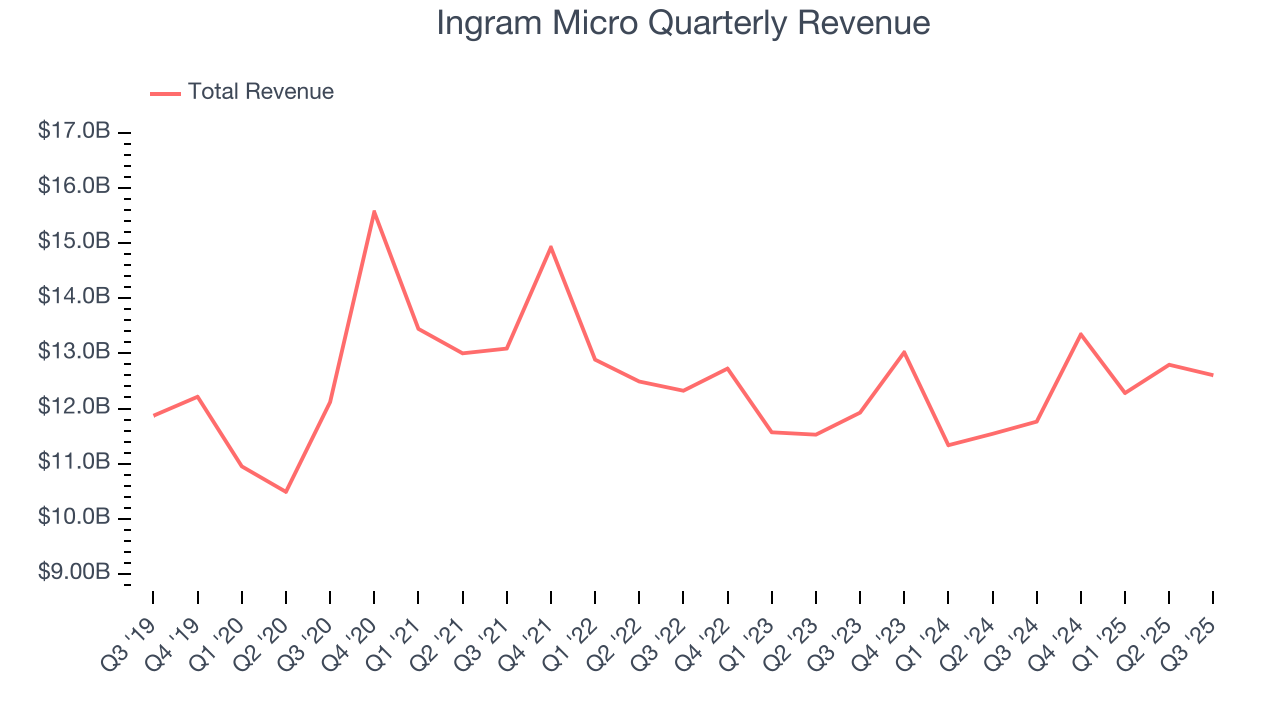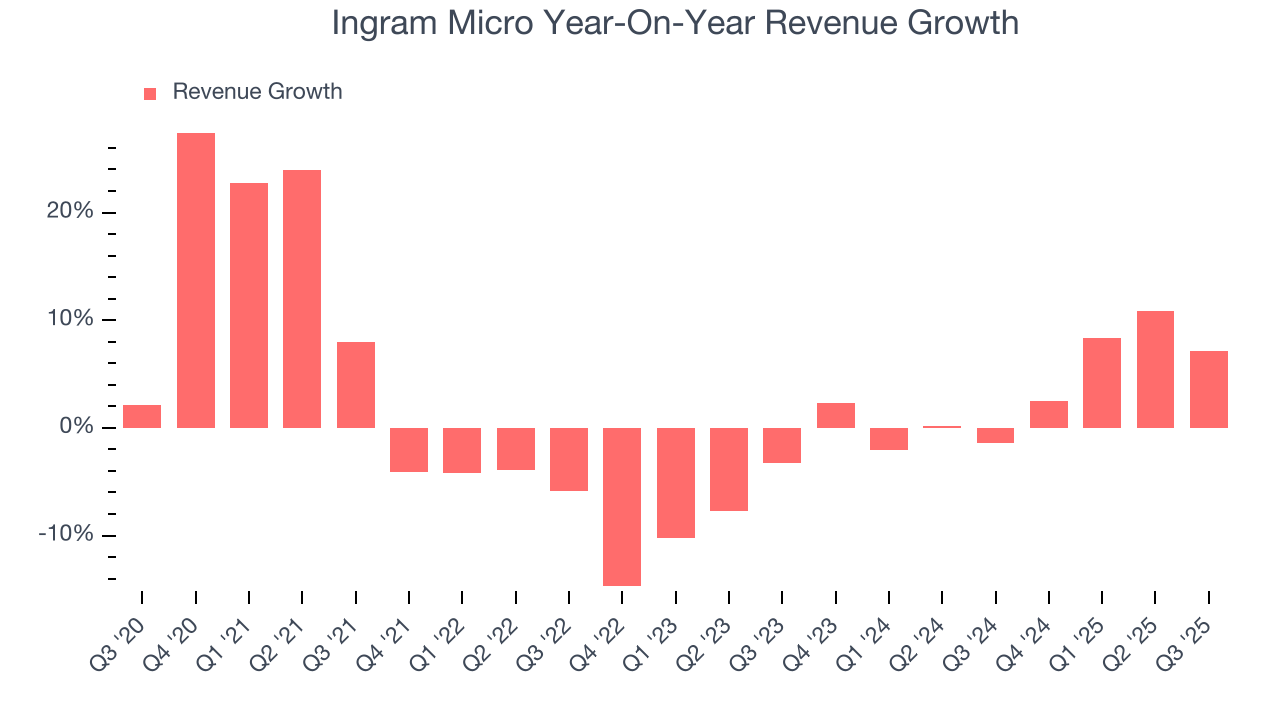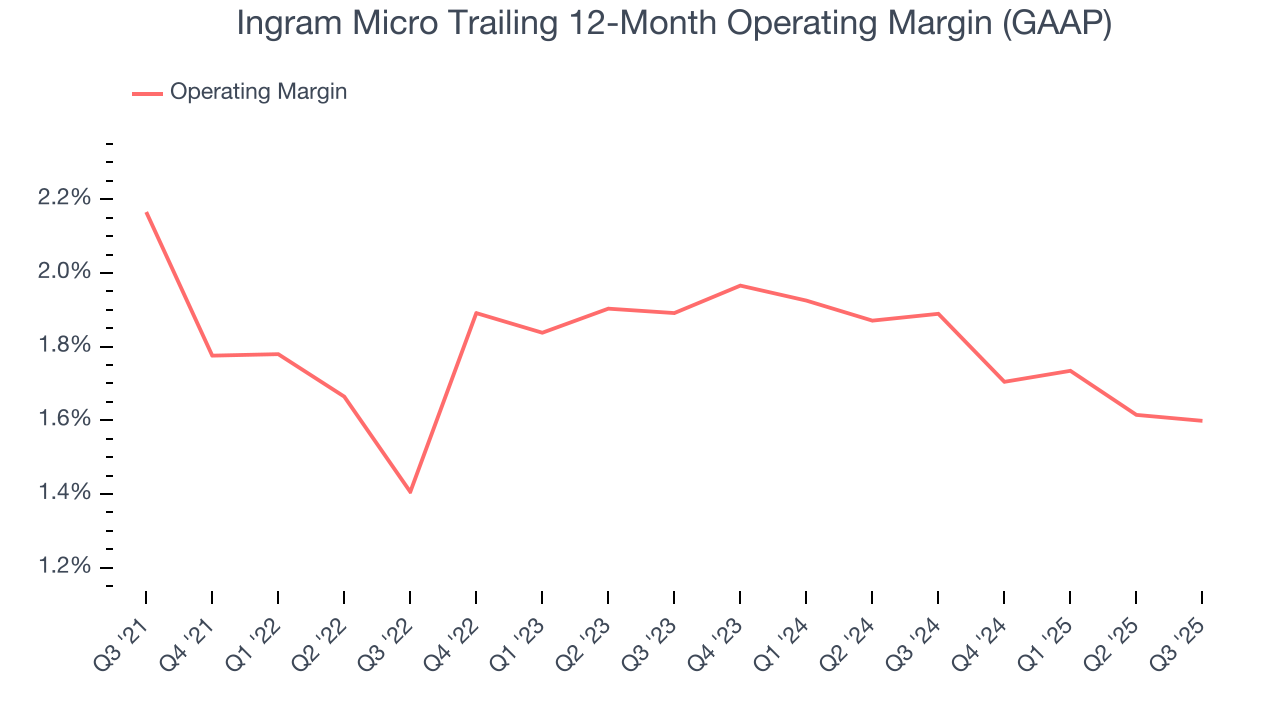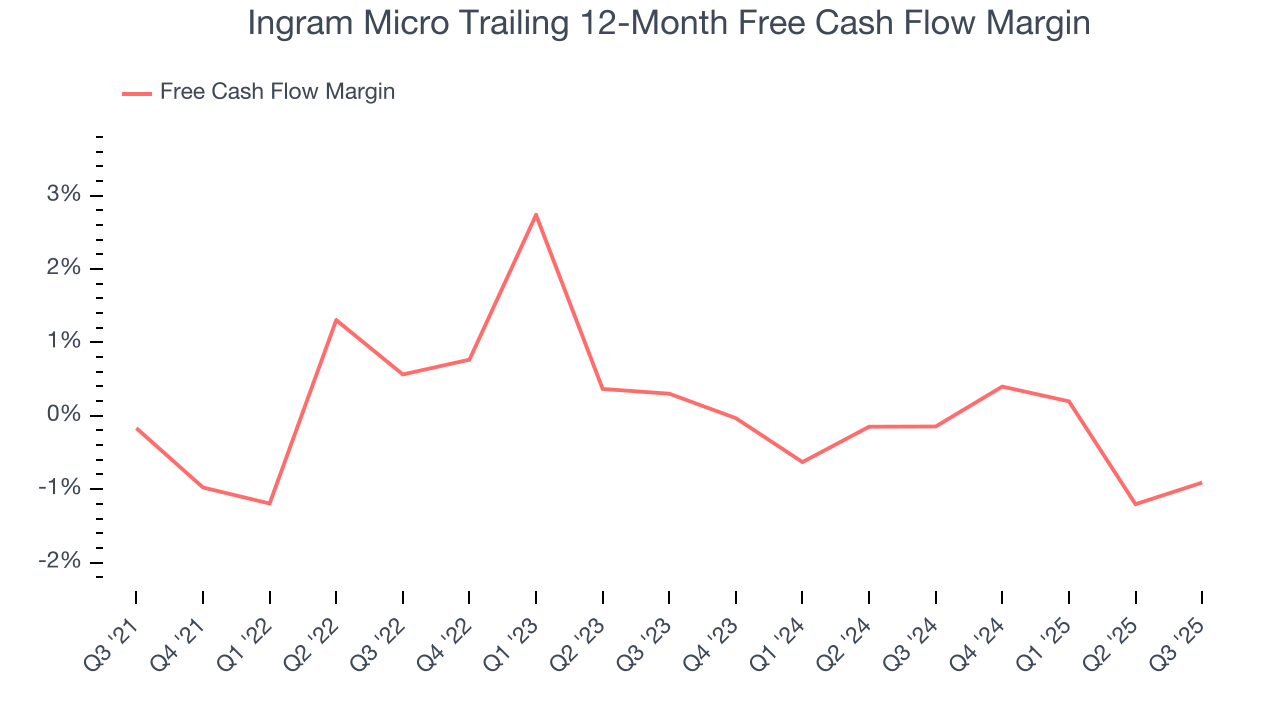
Ingram Micro (INGM)
We’re cautious of Ingram Micro. Its sales have underperformed and its low returns on capital show it has few growth opportunities.― StockStory Analyst Team
1. News
2. Summary
Why We Think Ingram Micro Will Underperform
Operating as the crucial link in the global technology supply chain with a presence in 57 countries, Ingram Micro (NYSE:INGM) is a global technology distributor that connects manufacturers with resellers, providing hardware, software, cloud services, and logistics expertise.
- Poor free cash flow generation means it has few chances to reinvest for growth, repurchase shares, or distribute capital
- Poor expense management has led to an adjusted operating margin that is below the industry average
- A positive is that its dominant market position is represented by its $51.02 billion in revenue and gives it fixed cost leverage when sales grow


Ingram Micro fails to meet our quality criteria. You should search for better opportunities.
Why There Are Better Opportunities Than Ingram Micro
High Quality
Investable
Underperform
Why There Are Better Opportunities Than Ingram Micro
At $21.69 per share, Ingram Micro trades at 6.9x forward P/E. This sure is a cheap multiple, but you get what you pay for.
It’s better to pay up for high-quality businesses with higher long-term earnings potential rather than to buy lower-quality stocks because they appear cheap. These challenged businesses often don’t re-rate, a phenomenon known as a “value trap”.
3. Ingram Micro (INGM) Research Report: Q3 CY2025 Update
IT distribution giant Ingram Micro (NYSE:INGM) beat Wall Street’s revenue expectations in Q3 CY2025, with sales up 7.2% year on year to $12.6 billion. On top of that, next quarter’s revenue guidance ($14.18 billion at the midpoint) was surprisingly good and 3.6% above what analysts were expecting. Its GAAP profit of $0.42 per share was 5.1% below analysts’ consensus estimates.
Ingram Micro (INGM) Q3 CY2025 Highlights:
- Revenue: $12.6 billion vs analyst estimates of $12.24 billion (7.2% year-on-year growth, 3% beat)
- EPS (GAAP): $0.42 vs analyst expectations of $0.44 (5.1% miss)
- Adjusted EBITDA: $342.2 million vs analyst estimates of $320.2 million (2.7% margin, 6.9% beat)
- Revenue Guidance for Q4 CY2025 is $14.18 billion at the midpoint, above analyst estimates of $13.68 billion
- Operating Margin: 1.8%, in line with the same quarter last year
- Free Cash Flow was -$175 million compared to -$315 million in the same quarter last year
- Market Capitalization: $5.16 billion
Company Overview
Operating as the crucial link in the global technology supply chain with a presence in 57 countries, Ingram Micro (NYSE:INGM) is a global technology distributor that connects manufacturers with resellers, providing hardware, software, cloud services, and logistics expertise.
Ingram Micro serves as a vital intermediary in the technology ecosystem, sourcing products from over 1,500 vendor partners including industry giants like Apple, Microsoft, Cisco, and Dell, and distributing them to more than 161,000 customers worldwide. These customers include value-added resellers, system integrators, retailers, and managed service providers who rely on Ingram's vast infrastructure and logistics capabilities.
The company operates through three main business lines. Its Technology Solutions division distributes a wide range of hardware and software products, from personal computers and smartphones to enterprise-grade servers and networking equipment. The Cloud division offers a marketplace with over 200 cloud solutions managing more than 36 million seats, allowing partners to sell third-party cloud-based services and subscriptions. Additionally, the company provides IT asset disposition services, helping organizations securely dispose of used technology through refurbishment, recycling, and resale.
A retailer might use Ingram Micro to source inventory of laptops, tablets, and accessories from multiple manufacturers through a single purchasing channel, while a managed service provider might leverage Ingram's cloud marketplace to offer Microsoft 365 subscriptions to their business clients without having to manage the relationship with Microsoft directly.
Ingram Micro generates revenue primarily through product sales and service fees. The company has been transforming from a traditional distributor to a technology solutions provider, investing heavily in its digital platform called Xvantage. This AI-powered platform automates many processes that previously required manual intervention, such as order status updates, price quotes, and vendor catalog management.
The company's global footprint includes 134 logistics and service centers worldwide, enabling it to reach approximately 90% of the global population with technology products and services. Ingram Micro's scale and infrastructure allow it to handle more than 850 million units of technology products across over 220,000 unique SKUs annually.
4. IT Distribution & Solutions
IT Distribution & Solutions will be buoyed by the increasing complexity of IT ecosystems, rising cloud adoption, and demand for cybersecurity solutions. Enterprises are less likely than ever to embark on these complicated journeys solo, and companies in the sector boast expertise and scale in these areas. However, cloud migration also means less need for hardware, which could dent demand for large portions of the product portfolio and hurt margins. Additionally, planning for potentially supply chain disruptions is ongoing, as the COVID-19 pandemic showed how damaging a pause in global trade could be in areas like semiconductor procurement.
Ingram Micro's primary competitors include global technology distributors such as TD SYNNEX (NYSE:SNX), Arrow Electronics (NYSE:ARW), and ScanSource (NASDAQ:SCSC), as well as regional players like ALSO Holding (SWX:ALSN), Esprinet (BIT:PRT), and cloud-focused distributors such as Pax8 and AppDirect.
5. Revenue Growth
A company’s long-term sales performance can indicate its overall quality. Even a bad business can shine for one or two quarters, but a top-tier one grows for years.
With $51.02 billion in revenue over the past 12 months, Ingram Micro is a behemoth in the business services sector and benefits from economies of scale, giving it an edge in distribution. This also enables it to gain more leverage on its fixed costs than smaller competitors and the flexibility to offer lower prices. However, its scale is a double-edged sword because it’s challenging to maintain high growth rates when you’ve already captured a large portion of the addressable market. For Ingram Micro to boost its sales, it likely needs to adjust its prices, launch new offerings, or lean into foreign markets.
As you can see below, Ingram Micro’s 2.2% annualized revenue growth over the last five years was sluggish. This shows it failed to generate demand in any major way and is a rough starting point for our analysis.

Long-term growth is the most important, but within business services, a half-decade historical view may miss new innovations or demand cycles. Ingram Micro’s annualized revenue growth of 3.4% over the last two years is above its five-year trend, but we were still disappointed by the results. 
This quarter, Ingram Micro reported year-on-year revenue growth of 7.2%, and its $12.6 billion of revenue exceeded Wall Street’s estimates by 3%. Company management is currently guiding for a 6.2% year-on-year increase in sales next quarter.
Looking further ahead, sell-side analysts expect revenue to grow 1.6% over the next 12 months, a slight deceleration versus the last two years. This projection doesn't excite us and indicates its products and services will see some demand headwinds.
6. Operating Margin
Ingram Micro’s operating margin might fluctuated slightly over the last 12 months but has generally stayed the same, averaging 1.8% over the last five years. This profitability was inadequate for a business services business and caused by its suboptimal cost structure.
Analyzing the trend in its profitability, Ingram Micro’s operating margin might fluctuated slightly but has generally stayed the same over the last five years. This raises questions about the company’s expense base because its revenue growth should have given it leverage on its fixed costs, resulting in better economies of scale and profitability.

This quarter, Ingram Micro generated an operating margin profit margin of 1.8%, in line with the same quarter last year. This indicates the company’s overall cost structure has been relatively stable.
7. Cash Is King
Although earnings are undoubtedly valuable for assessing company performance, we believe cash is king because you can’t use accounting profits to pay the bills.
Ingram Micro broke even from a free cash flow perspective over the last five years, giving the company limited opportunities to return capital to shareholders.

Ingram Micro burned through $175 million of cash in Q3, equivalent to a negative 1.4% margin. The company’s cash burn slowed from $315 million of lost cash in the same quarter last year.
8. Balance Sheet Assessment
Ingram Micro reported $802.6 million of cash and $4.27 billion of debt on its balance sheet in the most recent quarter. As investors in high-quality companies, we primarily focus on two things: 1) that a company’s debt level isn’t too high and 2) that its interest payments are not excessively burdening the business.

With $1.35 billion of EBITDA over the last 12 months, we view Ingram Micro’s 2.6× net-debt-to-EBITDA ratio as safe. We also see its $122.5 million of annual interest expenses as appropriate. The company’s profits give it plenty of breathing room, allowing it to continue investing in growth initiatives.
9. Key Takeaways from Ingram Micro’s Q3 Results
We were impressed by Ingram Micro’s optimistic revenue guidance for next quarter, which blew past analysts’ expectations. We were also glad its revenue outperformed Wall Street’s estimates. On the other hand, its EPS missed. Overall, this print had some key positives. The stock remained flat at $22.06 immediately after reporting.
10. Is Now The Time To Buy Ingram Micro?
Updated: December 4, 2025 at 11:02 PM EST
Are you wondering whether to buy Ingram Micro or pass? We urge investors to not only consider the latest earnings results but also longer-term business quality and valuation as well.
Ingram Micro’s business quality ultimately falls short of our standards. To begin with, its revenue growth was weak over the last five years. And while its scale makes it a trusted partner with negotiating leverage, the downside is its declining EPS over the last two years makes it a less attractive asset to the public markets. On top of that, its low free cash flow margins give it little breathing room.
Ingram Micro’s P/E ratio based on the next 12 months is 6.9x. While this valuation is optically cheap, the potential downside is big given its shaky fundamentals. We're fairly confident there are better stocks to buy right now.
Wall Street analysts have a consensus one-year price target of $25.42 on the company (compared to the current share price of $21.69).
Although the price target is bullish, readers should exercise caution because analysts tend to be overly optimistic. The firms they work for, often big banks, have relationships with companies that extend into fundraising, M&A advisory, and other rewarding business lines. As a result, they typically hesitate to say bad things for fear they will lose out. We at StockStory do not suffer from such conflicts of interest, so we’ll always tell it like it is.









